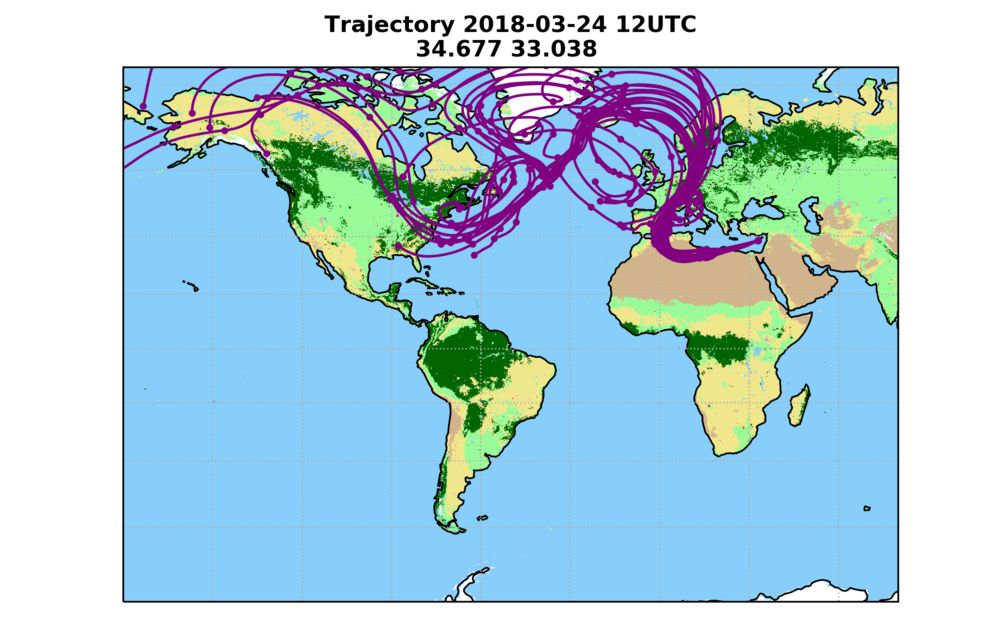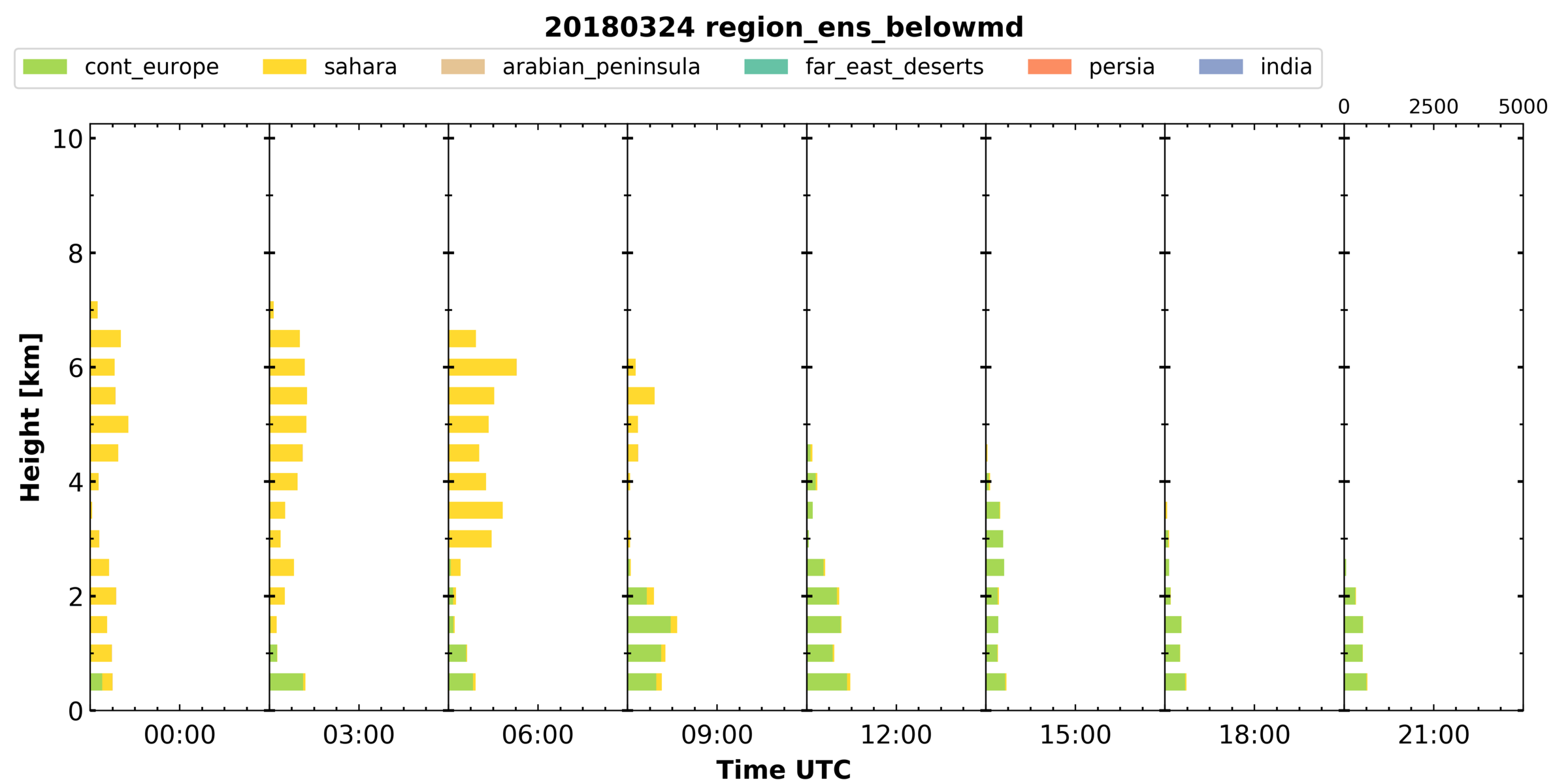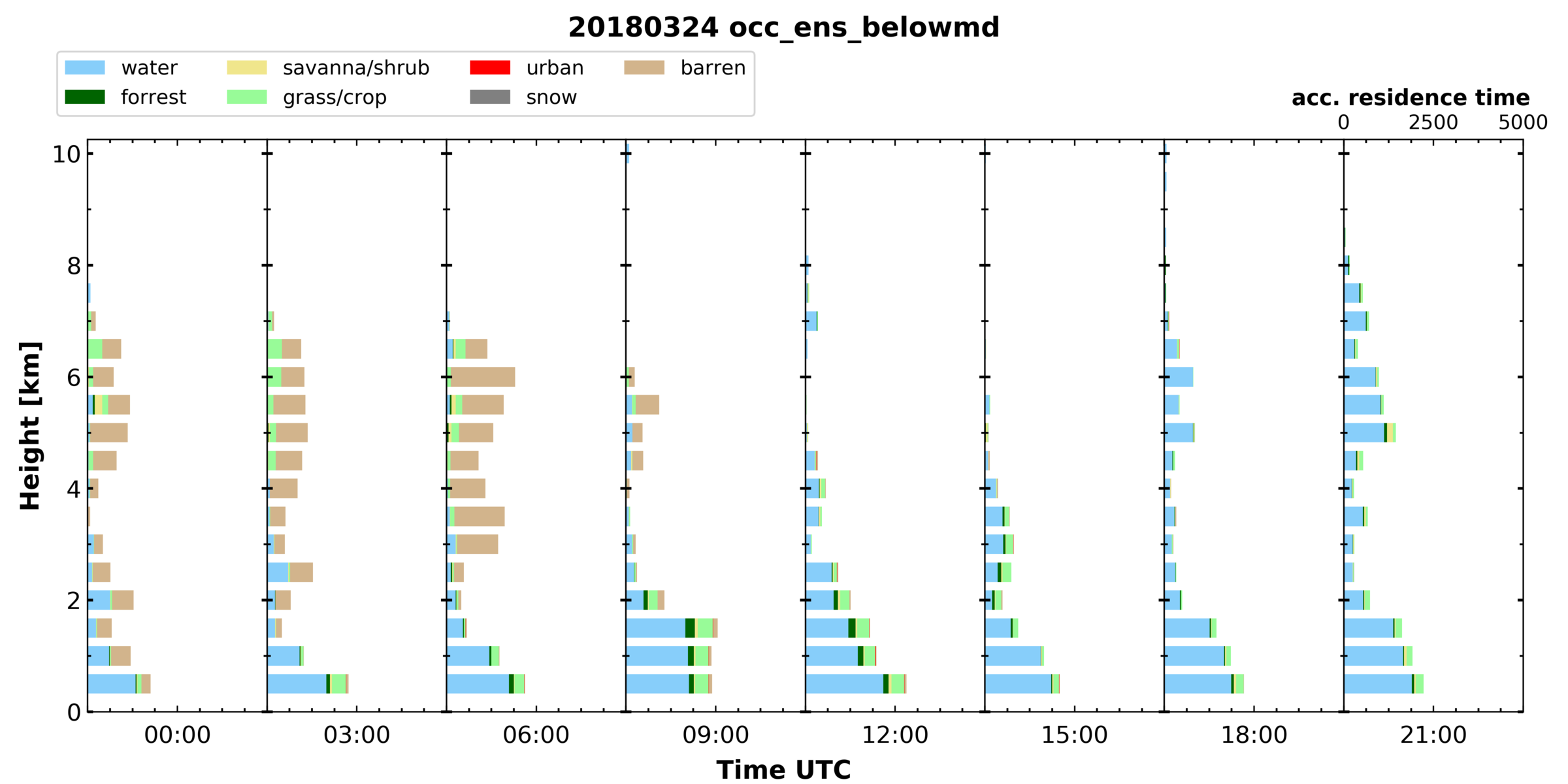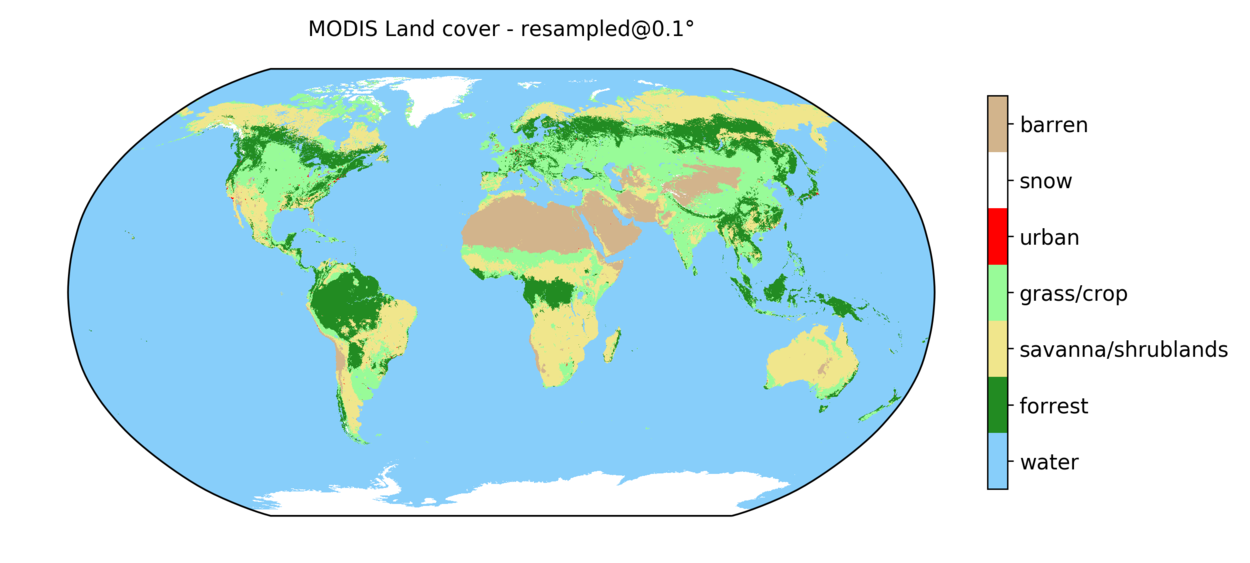trace: trajectory analysis tool
Ensemble backward trajectories are combined with a land cover classification for a temporally and vertically resolved airmass source attribution. At first, a 27-member ensemble of 10-day backward trajectories is calculated using HYSPLIT (Stein et al., 2015). Meteorological input data for HYSPLIT are taken from the GDAS1 dataset (https://www.ready.noaa.gov/gdas1.php) provided by the Air Resources Laboratory (ARL) of the U.S. National Weather Service’s National Centers for Environmental Prediction (NCEP). Each ensemble is generated using a small spatial offset in the trajectory endpoint. Whenever a trajectory is below the mixing depth provided in the GDAS1 data (“reception height”), the land cover is categorized using custom defined polygons according to land mass boundaries or a simplified version (number of categories reduced to 7) of the MODIS land cover classification (Friedl et al., 2002, Broxton et al., 2014). Hence, an airparcel is assumed to be influenced by the land surface if the trajectory is below the mixing depth. The residence time for each category is then the total time an airparcel fulfilled this criterion by land cover category. This calculation is repeated in steps of 3h in time and 500m in height to provide a continuous estimate on the airmass source and as a first hint on potential aerosol load. From the results a time-height plot of airmass source can be generated for a certain location, which is comparable to active remote sensing time-height plots.
Comprehensive documentation is available at trace-doc
Examples
Setup
trace is written in python3 and requires an extensive of additional packages. There are two options to acquire these packages.
local python installataion
Install all the packages listed in requirements.txt
docker container
Deployment may be simplified using a docker image which includes all the dependencies. A Dockerfile is included in this repository.
# build the Dockerfile
docker build -t trace_env .
# run an interactive bash on this image
docker run -v `pwd`:/trace -it trace_env /bin/bash
# or to build the documentation as well
docker run -v `pwd`/..:/trace -it trace_env /bin/bash
Please put your credentials in the output_meta.toml file.
Usage
Running trace consists of several steps, that are automated in the autorun.sh script.
Generating the a list of trajectories that are required, i.e. an input file for HYSPLIT:
python3 gen_hysplit_input.py --station [stationname]
After the HYSPLIT output is on hand, it can be checked if all required files are available:
python3 test_data_avail.py --station [stationname] --daterange [YYYYMMDD_begin-YYYYMMDD_end]
The actual processing is started with:
python3 run_assemble_hysplit.py --station [stationname] --daterange [YYYYMMDD_begin-YYYYMMDD_end]
From the netcdf files in the output directory the plots are generated by:
python3 plot2d.py --station [stationname] --daterange [YYYYMMDD_begin-YYYYMMDD_end]
Afterwards the files with the raw trajectires can be compressed to day-wise zip files:
python3 compress_data.py --station [stationname] --daterange [YYYYMMDD_begin-YYYYMMDD_end]
HYSPLIT input data
HYSPLIT ensemble backward trajectories are required. Please note that HYSPLIT itself is not provided within this package (The binary to run is hyts_ens with the respective CONTROL file).
In the default setup 10 days with a temporal resolution of 1h. Such an trajectory is calculated every 3h in steps of 500m. Conveniently the input trajectories are placed in the trajectories directory.
The filename of each trajectory should be hysplit_trajectory-[YYYYMMDD-HH]-[lat]-[lon]-[height]-[length].tdump
SETUP.CFG
&SETUP
KMSL=0,
tm_rain=1,
tm_tpot=0,
tm_tamb=1,
tm_mixd=1,
tm_relh=1,
tm_terr=1,
dxf=0.4,
dyf=0.4,
dzf=0.008,
/
TRAJ.CFG
&SETUP
tratio = 0.75,
delt = 0.0,
mgmin = 10,
khmax = 9999,
kmixd = 0,
kmsl = 0,
k10m = 1,
nstr = 0,
mhrs = 9999,
nver = 0,
tout = 60,
tm_pres = 1,
tm_tpot = 0,
tm_tamb = 1,
tm_rain = 1,
tm_mixd = 1,
tm_relh = 1,
tm_sphu = 0,
tm_mixr = 0,
tm_dswf = 0,
tm_terr = 1,
dxf = 0.40,
dyf = 0.40,
dzf = 0.01,
messg = 'MESSAGE',
/
Surface classification
Currently two sources for the surface classification are available. The raster-based MODIS land cover classification and the polygon-based geography names.
MODIS land cover
The MODIS land cover classification (Friedl et al., 2002, Broxton et al., 2014) with its 17 categories and 0.5km resolution is simplified to 7 categories (barren, snow, urban, grass, savanna/shrublands, forrest, water) and regridded to a 0.1º (~11km).
"named geography"
The extend and the name of a geography feature - usually a (sub-)continent - is defend within a .kml file. Examples for are available in the data directory for Europe and the shorelines of the Atlantic Ocean.
config files
Trace can by adjusted by two types of config files. One for the site or campaign named config_[site_name].toml. Examples are given for the site of Limassol and the Polarstern cruise PS113.
The second one - geonames_config.toml - is used to wire togehter the named geographies.
Used in
- Haarig, M., Ansmann, A., Gasteiger, J., Kandler, K., Althausen, D., Baars, H., Radenz, M., and Farrell, D. A.: Dry versus wet marine particle optical properties: RH dependence of depolarization ratio, backscatter, and extinction from multiwavelength lidar measurements during SALTRACE, Atmos. Chem. Phys., 17, 14199-14217, https://doi.org/10.5194/acp-17-14199-2017, 2017.
- Foth, A., Kanitz, T., Engelmann, R., Baars, H., Radenz, M., Seifert, P., Barja, B., Kalesse, H., and Ansmann, A.: Vertical aerosol distribution in the Southern hemispheric Midlatitudes as observed with lidar at Punta Arenas, Chile (53.2° S and 70.9° W) during ALPACA, Atmos. Chem. Phys. Discuss., https://doi.org/10.5194/acp-2018-1124, in review, 2018.
References
- Stein, A.F., R.R. Draxler, G.D. Rolph, B.J. Stunder, M.D. Cohen, and F. Ngan: NOAA’s HYSPLIT Atmospheric Transport and Dispersion Modeling System. Bull. Amer. Meteor. Soc., 96, 2059–2077, https://doi.org/10.1175/BAMS-D-14-00110.1, 2015
- Friedl, M. A., McIver, D. K., Hodges, J. C., Zhang, X. Y., Muchoney, D., Strahler, A. H., Woodcock, C.E., Gopal, S., Schneider, A., Cooper, A., Baccini, A., Gao, F., Schaaf, C.: Global land cover mapping from MODIS: algorithms and early results. Remote Sens. Environ., 83(1-2), 287-302, https://doi.org/10.1016/S0034-4257(02)00078-0, 2002
- Broxton, P.D., Zeng, X., Sulla-Menashe, D., Troch, P.A.: A Global Land Cover Climatology Using MODIS Data. J. Appl. Meteor. Climatol., 53, 1593-1605. http://dx.doi.org/10.1175/JAMC-D-13-0270.1, 2014
License
Copyright 2018, Martin Radenz MIT License



